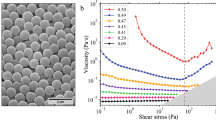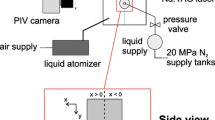Abstract
A state-of-the-art, high-speed video system has been used to observe floc disintegration occurring in the thin shear layer of a turbulent jet. The macrovideographic images have provided details of the breakage process that were heretofore unavailable. This information has been used to validate and quantify a force balance model that establishes a more rational framework for the description of floc breakage. It also has provided a much more detailed picture of the threshold levels of stress required for the breakage of specific floc structural types. The ultimate objective of this line of research is to use this framework to successfully describe the response of floc structures to hydrodynamic stress in coagulation processes and to provide a means by which substantial improvements can be made in solid-liquid separation processes.
Similar content being viewed by others
References
AI-Ani, S., Dyer, K. R. and Huntley, D. A.: 1991, ‘Measurement of the Influence of Salinity on Floc Density and Strength’,Geo-Marine Letters 11, 154.
Bache, D. H. and Al-Ani, S.: 1989, ‘Development of a System for Evaluating Floc Strength’,Wat Tech. 21, 529.
Camp, T. R. and Stein, P. C.: 1943, ‘Velocity Gradients and Internal Work in Fluid Motion’,L Boston Soc. Civil Engr 30, 219.
Glasgow, L. A. and Hsu, J.: 1982, ‘An Experimental Study of Floc Strength’,AIChE J. 28, 779.
Glasgow, L. A., Kim, Y. H. and Hsu, J.: 1985, ‘Characterization of Turbulence-Induced Aggregate Breakage’, in Flocculation, Sedimentation and Consolidation, Proceedings of the Engineering Foundation Conference, pp. 191–204.
Glasgow, L. A. and Liu, X.: 1991, ‘Response of Aggregate Structures to Hydrodynamic Stress’,AIChE J. 37, 1411–1414.
Healy, T. W. and La Mer, V. K.: 1964, ‘The Energetics of Flocculation and Redispersion by Polymers’,J. Coll. Sci. 19, 323.
Higashitani, K., Inada, N. and Ochi, T.: 1989, ‘Floc Breakup in Contraction Flow to Orifice’, Presented at AIChE Annual Meeting, San Francisco.
Hinze, J. O.: 1955, ‘Fundamentals of the Hydrodynamic Mechanism of Splitting in Dispersion Processes’,AIChE J. 1, 289.
Hsu, J. and Glasgow, L. A.: 1983, ‘Floc Size Reduction in the Turbulent Environment’,Particulate Sci. Tech. 1, 205.
Kolmogorov, A. N.: 1949,Doklady Akad. Nauk SSSR 66, 825.
Lee, C. W. and Brodkey, R. S.: 1987, ‘A Visual Study of Pulp Floc Dispersion Mechanisms’,AIChE J. 33, 297.
Matsuo, T. and Unno, H.: 1981, ‘Forces Acting on Floc and Strength of Floc’,J. Envir Engr. Div. ASCE 107, 527.
Smith, D. K. W. and Kitchener, J. A.: 1978, ‘The Strength of Aggregates Formed in Flocculation’,Chem. Engr. Sci. 33, 1631.
Wagle, D. G., Lee, C. W. and Brodkey, R. S.: 1988, ‘Further Comments on a Visual Study of Pulp Floc Dispersion Mechanisms’,Tappi J. 71, 137.
Author information
Authors and Affiliations
Rights and permissions
About this article
Cite this article
Liu, S.X., Glasgow, L.A. Aggregate disintegration in turbulent jets. Water Air Soil Pollut 95, 257–275 (1997). https://doi.org/10.1007/BF02406169
Received:
Accepted:
Issue Date:
DOI: https://doi.org/10.1007/BF02406169




